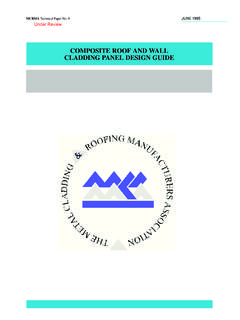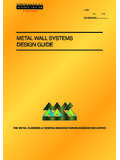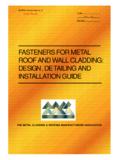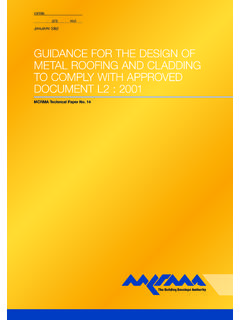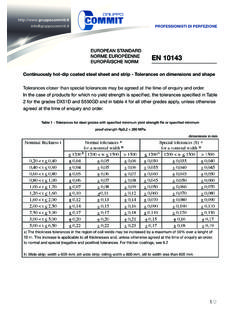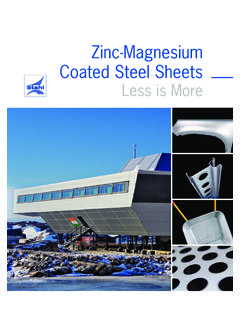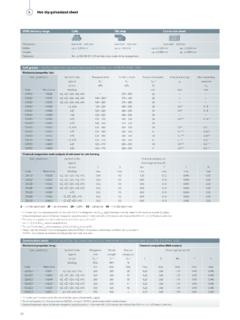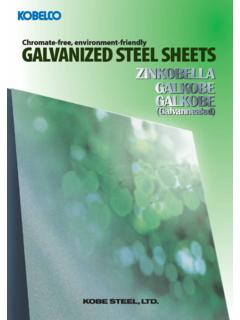Transcription of APPROPRIATE SELECTION OF METAL THICKNESS …
1 APPROPRIATE SELECTION OF METAL THICKNESS FOR USE IN WALLING AND ROOFING APPLICATIONSCI/SfBRh2(4-)SEPTEMBER 2010 MCRMA Technical Paper No. 20 Contents Page Foreword Summary Introduction Nominal THICKNESS /gauge Steel Aluminium Normal range of thicknesses Commonly used coil widths Yield strengths construction purposes Tolerance specification potential for non-compliance Steel Roofing weather sheet Walling weather sheet Aluminium weather sheet Flashings Liner sheet Measuring the THICKNESS of a coil or sheet CE Marking ensuring that the correct material is delivered Safe working load as a function of material THICKNESS Use of load span tables Non fragility Walkability Use of load span tables Profile shape Fixing regime Fire performance Roofing applications Walling applications Interaction with other building components Conclusions Bibliography 15 The METAL Cladding & Roofing Manufacturers Association Limited and Engineered
2 Panels in Construction Limited. September 2010 For up to date information on METAL roof and wall cladding, including downloadable construction details, visit effect of THICKNESS (gauge) on the performance of METAL systems in building applications cannot be under-estimated and the responsibility for not only ensuring that APPROPRIATE materials are specified, but selected and used correctly is placed upon all parties within the supply regard to the SELECTION of coil or sheet for use in roll-forming applications it is of particular importance that the material selected and used complies fully with the APPROPRIATE standards of tolerance on dimension and shape: BS EN 10143:2006 for pre-finished steel and BS EN 485 Part 4 for cold rolled aluminium with normal tolerance as a minimum those specifying and using materials the key points must be: - To state the standard that is to apply.
3 Ensure that the material to be ordered and used: - Meets the requirements of the standard. Is delivered correctly. Ensure that the structural calculations used are specific to the profile proposed and the nominal THICKNESS of the material proposed. Ensure that the reaction to fire performance is valid for the nominal THICKNESS of the material use of METAL for roofing and walling applications has, through structural calculation and over a period of successful performance in service, determined those thicknesses of material which are normally performance of these materials in use (including the construction phase) is determined by loading arising from positive and negative forces, wind, dead weight and point load or impact, with the main requirements being: - Safety in use. Weatherproofing Water penetration Air tightness Robust details Appearance and ability to maintain in the long materials which vary beyond the limits of the tolerances allowed introduces the possibility that the building design performance will not be met and, although this may result in short term savings, could add considerably to the whole life costs of the building through poor performance and potential for remedial works or METAL Cladding and Roofing Manufacturers Association represents leading manufacturers in the METAL roofing and cladding industry and seeks to foster and develop a better understanding amongst specifiers and end users alike of the most effective use of METAL building products, components and Association has two main objectives: -1.
4 To make sure that published standards in the UK and Europe for METAL roof and wall cladding are in accordance with best practice so as to ensure a European-wide standard of product excellence which can be written into product specifications. 2. To provide a basis for technical excellence encompassing product development, component and detail design, improved manufacturing and co-operation on installation techniques and standards Summary3It is the clearly stated position of the MCRMA and its members that the best assurance of compliance with the APPROPRIATE standards and performance expectation is to source systems and products from reputable manufacturers who can demonstrate the pedigree of the materials used and support design requirements with job specific cladding systems provide an efficient, attractive and reliable solution for a wide variety of external building envelopes.
5 Over the years they have evolved from the single-skin METAL cladding often associated with agricultural buildings to sophisticated systems which are used in industrial, retail and leisure applications throughout the United , as with all construction components, the ability of the cladding to satisfy its functional requirements is dependent on its correct specification and installation and, equally as important, on its interaction with the other elements of the building envelope and the continuing quest for improved cost effectiveness in all forms of business generally and construction in particular, combined with the need to meet budgetary constraints, the consideration of alternative methods and choice of materials to meet a specified desired outcome is a valid and necessary process that must be undertaken. The completed cost of construction is directly impacted by the costs of materials used within the construction process.
6 It is key, however, in each step of this process to understand that any one choice of a material type or component does not exist in isolation and has potentially wider reaching implications on other aspects of the performance of the completed individual components that make up the cladding system are often specified and supplied separately, with the potential for insufficient attention being paid to the way in which they paper will focus on the potential effects of seeking to reduce the effective gauge of a steel sheet used in the manufacture of an external cladding will consider the following: - Nominal THICKNESS and adherence to the relevant standards. Tolerance specification and the potential for non-compliance within a normal distribution. Safe working load as a function of material gauge. Use of APPROPRIATE load span tables as guides to cladding performance incorporating bending moments.
7 Potential impacts on performance and other components in the building IntroductionWhilst the THICKNESS of METAL selected for use will vary depending on product and application the nominal values in Table 1 are generally accepted as being normally used in the 1 Millimetres (mm)SteelAluminiumRoof Weather to Weather to Liner sheet METAL is manufactured at the mill it is produced to a target or nominal THICKNESS . However, as with all manufacturing processes it is inevitable that there is a variation in the production process and, as such, variations in the final THICKNESS of the finished material is SteelWith regard to the SELECTION of steel for use in METAL roofing and cladding applications gauge tolerances for hot dipped products are determined from the standard BS EN 10143:2006, Continuously hot-dip coated steel sheet and strip: tolerances on dimensions and shape, and the allowed positive or negative variance (tolerance) compared with the nominal THICKNESS of the material varies with the nominal THICKNESS , coil width and the grade of steel (as determined by its minimum specified yield strength).
8 Under normal circumstances the steel coil used in UK markets is typically within the following ranges: - Nominal steel thicknesses of between and Coil widths of: - less than 1200mm greater than 1200mm and less than or equal to 1500mm Minimum specified yield strengths of: - less than 260 MPa (260 MN/mm2) AluminiumThe standard from which the tolerances on THICKNESS of aluminium sheet may be determined is as follows: - BS EN 485: Aluminium and aluminium alloys, sheet, strip and plate. Part 4 tolerances on shape and dimensions for cold-rolled productsThe tolerances positive or negative vary according to the Alloy Group (I or II) which relate to the chemical composition of the materials and are determined according to BS EN 573:3. Material belonging to Alloy Group I is normally used for roll forming and construction purposes in the Nominal Normal range of thickness5 From the UK and European perspective the key issue in terms of performance under load relates to the bending moment of any force , the yield strength of steel supplied for the manufacture of wall or roof profiles is in the range less than 260 MPa and is generally of yield strength 220 outlined above, aluminium used for roll formed products is in Alloy Group I and usually from series 3000 and 5000 alloys for which the maximum specified magnesium and manganese contents are each no greater than % and their sum no greater than %.
9 With reference to the standards applying the tolerances on THICKNESS (in millimetres) allowable for steel materials with these typical characteristics are as below: -The profile of the finished product will tend to dictate the requirements of the manufacturer with regard to SELECTION of the coil width of the material in the first general terms most manufacturers seek to achieve a cover width of the finished product of 1 metre with steel roofing and walling products. Weather sheets with a typical profile depth of 31mm or 32mm generate a need for coil widths of the order of 1220mm to 1250mm. Liner sheets with a typical profile depth of 19mm or 20mm generate a need for coil widths of the order of 1110mm to sheet products available in the market typically provide cover widths of the finished product of up to 500mm and would as such require coil width of up to 700mm although certain profiles could require coil widths of less than is worthy of note that aluminium profiles made from coils of greater width are available in the Commonly used coil Yield strengths construction purposesTable 2 Nominal THICKNESS Tolerance in mm for given widthNormal TolerancesSpecial TolerancesMinMax 12001200 1500 12001200 summary of the tolerances on THICKNESS allowable for aluminium from Alloy Group I are contained in the following table.
10 -Table 3 Specified THICKNESS Tolerance in mm for given widthMinMax 10001000 12501250 may be seen from the foregoing key points with regard to material specification there are several factors to be considered when selecting material(s). SteelIn terms of coil width and yield strength the ranges for compliance are relatively in terms of the nominal THICKNESS of the METAL it is important that: - The material is specified to the APPROPRIATE tolerance. The material is supplied as specified. It is understood what is being measured and order to highlight the potential for non-compliance it is sensible to consider the case for each nominal THICKNESS used in everyday circumstances as follows: Roofing weather sheetNormally the outer sheet of a roof will utilise a profile manufactured from coil of 1250mm width with nominal THICKNESS of and minimum specified yield strength of 220 BS EN 10143.


